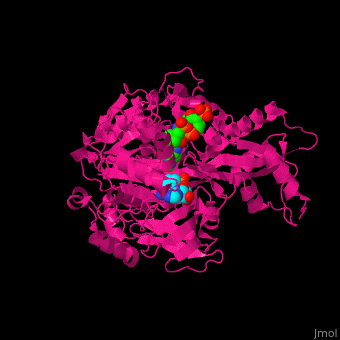Acetyl-CoA synthetase
From Proteopedia
(Difference between revisions)
| (22 intermediate revisions not shown.) | |||
| Line 1: | Line 1: | ||
| - | + | <StructureSection load='' size='350' side='right' scene='49/492048/Cv/9' caption='Acetyl-CoA synthetase complex with CoA and AMP (PDB code [[2p2j]])'> | |
| - | + | __TOC__ | |
| - | + | == Function == | |
| - | + | ||
| - | + | ||
| - | + | ||
| - | + | ||
| - | + | '''Acetyl-CoA synthetase''' (ACS) catalyzes the ligation of acetate and CoA to form acetyl-CoA with the conversion of ATP to AMP and pyrophosphate. ACS is an ATP-dependent AMP-binding enzyme. Mg+2 is ACS cofactor. ACS participates in the pathway which fixes CO2 under anaerobic conditions. ACS acetylates the response regulator for flagellar movement and for chemotaxis - CheY. <ref>PMID:14769018</ref> | |
| - | + | == Relevance == | |
| + | |||
| + | Acetyl-CoA is used in aerobic respiration to produce energy and electron carriers and for lipid biosynthesis, in histone acetylation which is critical for DNA condensation to chromatin. | ||
| + | |||
| + | == Structural Highlights == | ||
| + | *<scene name='49/492048/Cv/10'>CoA binding site</scene>. Water molecules shown as red spheres. | ||
| + | *<scene name='49/492048/Cv/7'>AMP binding site</scene>. | ||
| + | *<scene name='49/492048/Cv/8'>CoA/AMP binding site</scene> ([[2p2j]]).<ref>PMID:17497934</ref> | ||
| + | |||
| + | ==3D structures of acetyl-CoA synthetase== | ||
| + | [[Acetyl-CoA synthetase 3D structures]] | ||
| + | </StructureSection> | ||
| - | + | == References == | |
| - | + | <references/> | |
| - | [[ | + | [[Category:Topic Page]] |
| - | + | ||
| - | + | ||
| - | + | ||
Current revision
| |||||||||||
References
- ↑ Jogl G, Tong L. Crystal structure of yeast acetyl-coenzyme A synthetase in complex with AMP. Biochemistry. 2004 Feb 17;43(6):1425-31. PMID:14769018 doi:10.1021/bi035911a
- ↑ Reger AS, Carney JM, Gulick AM. Biochemical and crystallographic analysis of substrate binding and conformational changes in acetyl-CoA synthetase. Biochemistry. 2007 Jun 5;46(22):6536-46. Epub 2007 May 12. PMID:17497934 doi:http://dx.doi.org/10.1021/bi6026506

